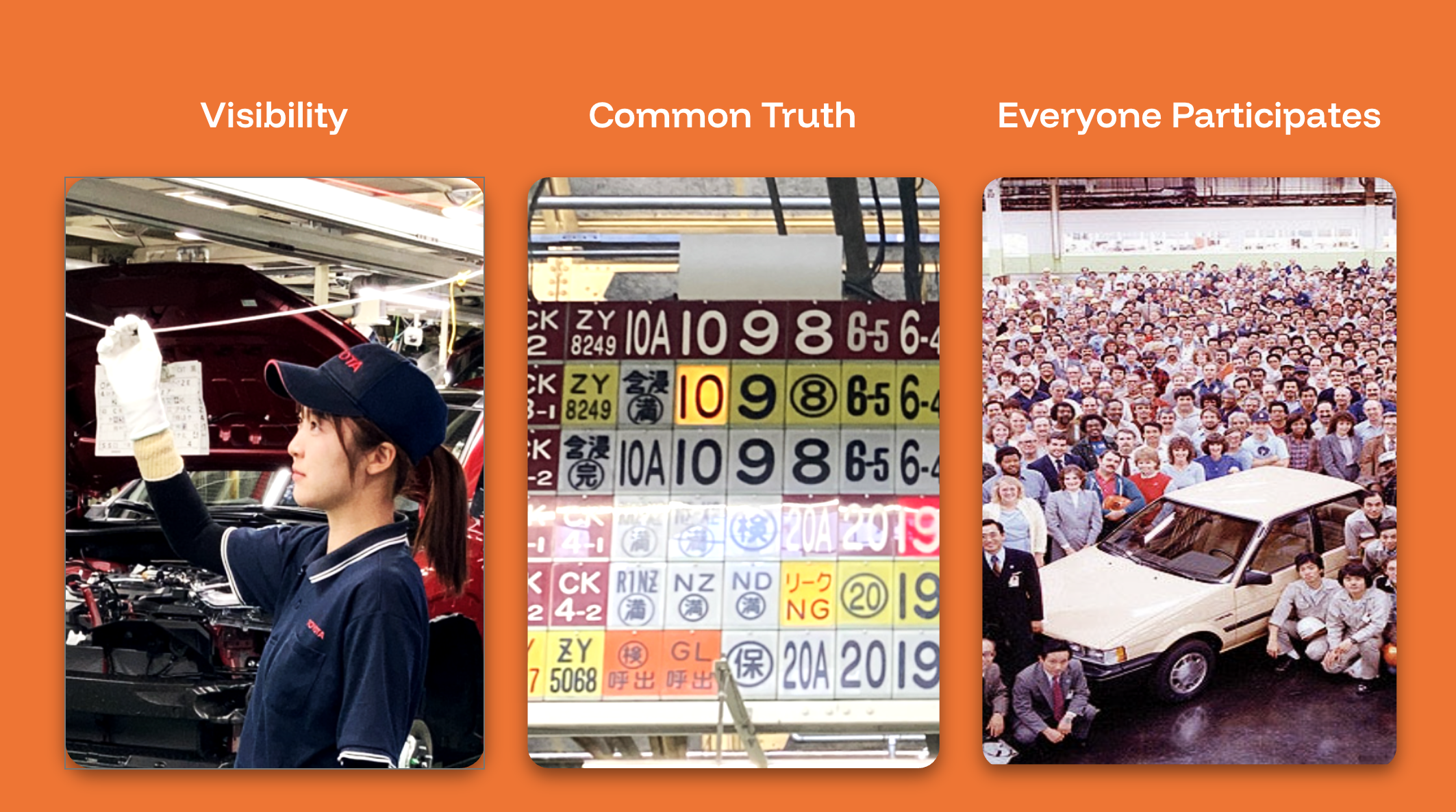Kaizen solved the human problem in 1947
Japan, 1947. Toyota is producing a few thousand vehicles per year, close to bankruptcy after the war. They call in an American statistician named W. Edwards Deming to fix things. If you’re a history buff, you can read more about him here.
Deming introduces a methodology that the Japanese translated as kaizen: continuous, effortless improvement by everyone over time.
Here’s what made it revolutionary: Kaizen didn’t treat improvement as something consultants did to workers. It made workers the agents of change. Instead of big transformation projects run by outsiders every few years, Toyota established a North Star strategy (Hoshin kanri) and made sure it moved horizontally through the organization. Executives walked the floors to learn from the front line. They collaborated with managers. Maintaining total quality and their competitive advantage required aligning the whole organization around those goals. And because the people doing the work were often the ones suggesting changes, there was no resistance. They owned the process of making tiny improvements every day.
Kaizen operates on three principles: visibility, common truth, and distributed ownership. But the real genius was recognizing that improvement is a human problem that requires everyone’s participation. You can't mandate change from above. You have to enable it from the bottom up.

I’ve spent months on transformation projects only to discover that teams had no visibility into what other teams were doing. I’ve watched one group deploy a fix that solved their bottleneck but created chaos downstream.
But the process problems were never the real issue.
I could optimize all day long. What I couldn't fix was people’s fear of being watched, their exhaustion from constant change, or their skepticism that this time would be different from all the rest.
Instead of letting problems snowball and then launching years-long projects to fix them, companies can unlock everyone in the organization to make small fixes all the time. The approach transformed Toyota from a struggling company to a juggernaut. It’s now the largest automaker in the world, producing 10.8 million vehicles in 2024.
So why doesn’t every enterprise practice kaizen? For one, we don’t have the full visibility of a factory floor anymore. Kaizen was developed to build efficiencies into work that delivered atoms, not bits. Modern work is fractured into teams and workspaces that have their own tribal knowledge and ways of doing things.
At conferences for Six Sigma black belts, we joke about “black belt burnout.” You spend years doing the hard work of transformation—getting people to change, standing in the shadows while others take credit, absorbing jab after jab. After five years, most people ask themselves: “Why am I being a punching bag when I’m actually helping?”
Why I Couldn't Solve the Human Problem
Let me be specific about four human problems that sabotage traditional transformation:
- The fear problem: When I walked into that office and the lights were off, they weren’t wrong to have us pegged as the job cutters. They’d seen consultants before. They’d seen “optimization” projects that ended in layoffs. Why should they trust me?
I would sit with people and say: “I’m not here to take your job. You clearly have these development goals you want to achieve. If you could get even 20% of your time back, you could actually work on the things that matter to you.” Some people believed me. Many didn’t. - The ownership problem: Even when people trusted me, they didn’t own the solutions. I was the expert telling them how to work differently. The best I could hope for was compliance, but rarely do people commit to something they can’t own.
- The visibility problem: No single person could see the whole system. Which meant solutions that helped one team often hurt another. And by the time we discovered the problem, we’d already spent months implementing the “fix.”
- The speed problem: All of this took so long that people's trust eroded faster than we could build it. “Just trust me,” I’d tell executives, burning down credibility tokens I’d built up over years. By the time we proved something worked, leadership had often moved on.
All of these are human problems that require a fundamentally different approach. And there are not enough people who can do this work and navigate the human problem.
We tried to solve it in two ways: make the work more fun (never going to happen) or train more people. I ran Six Sigma certification programs at Lenox and Stripe. The last person I certified when I was at Lennox was my wife—she went reluctantly because her VP mandated it. Now she loves it!
But training only goes so far. Even when people know how to do process engineering, the work itself remains tedious. And consultants don’t do the hard work of change management. They come for a timebound project, then exit the building.
For transformation to work, people have to trust the process, believe in the change, and feel ownership over improvements.
Enter kAIzen
Kaizen unlocks continuous transformation, but it requires certain conditions. Everything has to be visible. Everyone needs to participate. And it has to go fast so the patient doesn’t bleed out on the table: speed to document problems and speed to fix them.
I would have been the first to tell you that this dream would be difficult to realize at most modern enterprises where the factory floor is a business process that happens on screens.
Then I was introduced to Klarity.
In my next piece, I’ll walk you through how Klarity unlocks kaizen.


